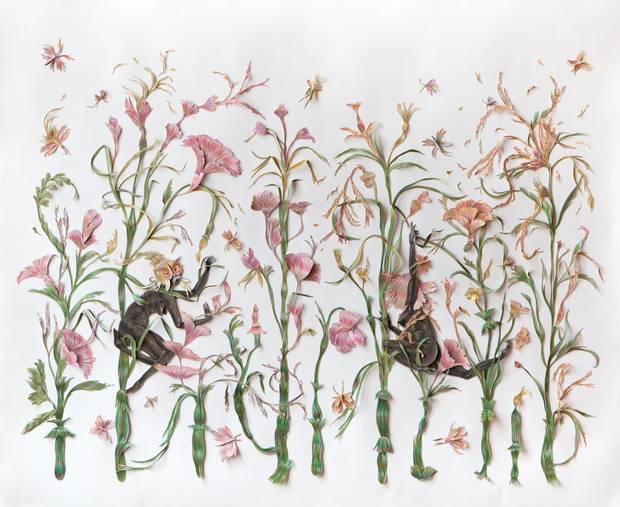You can spy it through the window from the frozen street: a clump of yellow flowers – black-eyed Susans, looks like – sprouted from the tiny crack between the wall and the floor, maybe blown in on some gallery-goer, deposited by chance where a seed might develop, then left, maybe through pity, unpicked by the attendants. The growth has matured now into a proud weed, reaching up toward the museum lights. In its audacity, it demands attention – awe, even. To discover that American artist Tony Matelli made it from bronze shouldn't diminish your wonder. The work is part of OCAD University Onsite Gallery's new exhibition, The Sunshine Eaters.
Matelli's flower is an emblem of hope. And in an era of cataclysms, a scary and overwhelming nexus that includes extreme weather events, climate change, dangerous populism, hate crimes, water crises, widening economic inequality and brinkmanship, hope is a powerful variety of sustenance. It is the glimpse of some way forward. For The Sunshine Eaters, curator Lisa Deanne Smith has gathered the work of local, national and international artists who have each turned their attentions toward the land and its flora and fauna in search of those ways forward.
The project began with Abenaki documentary-maker Alanis Obomsawin's 2014 film Trick or Treaty?, discussing government deception in Treaty 9, the agreement covering Northern Ontario, in which oral promises, the treaty commissioner's diaries seem to evidence, were omitted from the written treaty. Smith was struck particularly by scenes of the Nishiyuu Walkers – a group of Cree youth who undertook a 1,600-kilometre, 69-day trek in 2013 from the community of Whapmagoostui in Northern Quebec to Parliament Hill in support of the Idle No More movement. Travelling traditional Cree, Algonquin and Mohawk trade routes, their protest was intimately connected to the land. Their journey inspired Smith to ask across disciplines, cultures and ages: How and where do we locate hope?
Entering the main gallery space, British Columbia-based artist Brian Jungen presents two plastic jerrycans perforated with structural patterns found in both biology and traditional Indigenous beading. The design of Seed mimics the swirl of sunflower seeds arranged mathematically on a flower head, modelling the Fibonacci spiral. The gesture suggests an intelligence special to plants. Were we to look, we might find worthy teachers all around us.
In a series of new coloured-pencil paper-cut works, Toronto artist Winnie Truong pictures spritely characters, uninterested in the viewer, entwining themselves among their grassy settings, becoming them. It is a vision of harmony between species.

Seed, by British Columbia-based artist Brian Jungen.

The Gauntlet, by Toronto artist Winnie Truong.
On the back wall, a tapestry by Jamaican-born artist Ebony G. Patterson, brightly embellished and bejewelled, imagines a birthday party for a group of black children killed by violence. The florid ornamenting, much like a rapper's necklace, are tools to declare presence and claim dignity, she explains at an artist talk with Smith and artist Nick Cave before the opening.
You'll have noticed them as soon as you walked in: The Sunshine Eaters includes two Soundsuits by Cave, the celebrated American artist known for his wearable sculptures. Each radiates its own particular splendour. Cave made his first from twigs in response to the 1991 Rodney King beating. It was intended as a suit of armour capable of masking one's identity – survival equipment for a black man in America. One of the pair on view features a branchlike structure enveloping the wearer like a tree. Antique children's toys hang like fruit. The works cause me to recall that under tremendous stress, it is the natural response of many plants to create flowers.
Beyond the metaphors for growth, adaptation and resiliency, the kind of poetry that comes easily when speaking of nature's pretty things, The Sunshine Eaters presents a sense of interconnection that spans cultural difference. In the face of piling crises, we don't yet know where to find solutions. Though it seems we agree: The land under our feet is a good place to start.
The Sunshine Eaters continues at the OCADU Onsite Gallery until April 15 (ocadu.ca/gallery/onsite).
